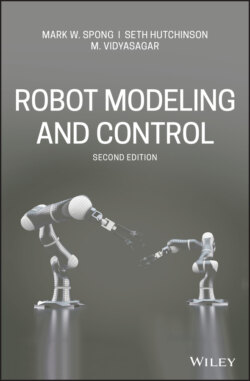Читать книгу Robot Modeling and Control - Mark W. Spong - Страница 61
2.4.2 Rotation with Respect to the Fixed Frame
ОглавлениеMany times it is desired to perform a sequence of rotations, each about a given fixed coordinate frame, rather than about successive current frames. For example we may wish to perform a rotation about x0 followed by a rotation about y0 (and not y1!). We will refer to o0x0y0z0 as the fixed frame. In this case the composition law given by Equation (2.17) is not valid. It turns out that the correct composition law in this case is simply to multiply the successive rotation matrices in the reverse order from that given by Equation (2.17). Note that the rotations themselves are not performed in reverse order. Rather they are performed about the fixed frame instead of about the current frame.
To see this, suppose we have two frames o0x0y0z0 and o1x1y1z1 related by the rotational transformation . If R ∈ SO(3) represents a rotation relative to o0x0y0z0, we know from Section 2.3 that the representation for R in the current frame o1x1y1z1 is given by (. Therefore, applying the composition law for rotations about the current axis yields
(2.20)
Thus, when a rotation is performed with respect to the world coordinate frame, the current rotation matrix is premultiplied by to obtain the desired rotation matrix.
Example 2.7. (Rotations about Fixed Axes)
Referring to Figure 2.9, suppose that a rotation matrix represents a rotation of angle ϕ about y0 followed by a rotation of angle θ about the fixed z0. The second rotation about the fixed axis is given by , which is the basic rotation about the z-axis expressed relative to the frame o1x1y1z1 using a similarity transformation. Therefore, the composition rule for rotational transformations gives us
(2.21)
It is not necessary to remember the above derivation, only to note by comparing Equation (2.21) with Equation (2.18) that we obtain the same basic rotation matrices, but in the reverse order.
Figure 2.9 Composition of rotations about fixed axes.
